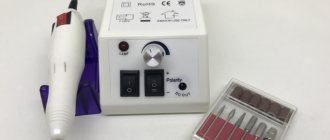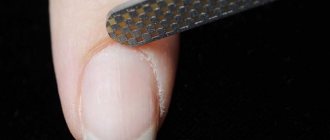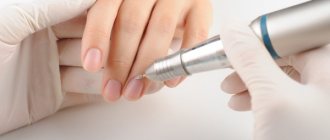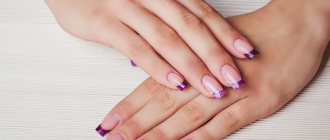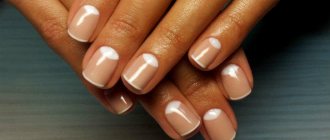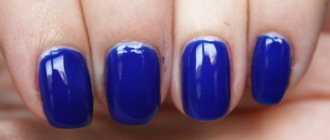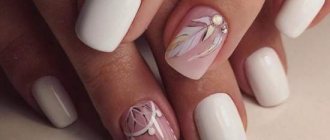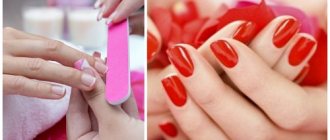Hardware or edged manicure, which is better and safer - is determined by comparing the pros and cons of the two methods. It’s quite rare to see a woman with untidy nails these days. To achieve results, each of them uses the services of a specialist or performs the care independently, practically without thinking about technology.
Some people believe that the hardware and classical methods of nail care are one and the same. But these are two completely different methods, both with their advantages and disadvantages. If done incorrectly, it can negatively affect your overall health.
Comparison of hardware and edged manicure techniques
To decide on the appropriate nail treatment method, you need to know all the intricacies of both procedures. You need to pay attention to the distinctive characteristics of mechanical and classical care techniques and choose an option according to individual preferences.
What is the difference between nail treatment during a hardware manicure and a classic one?
The classic method requires the following tools:
- files for correcting and polishing the nail plate;
- scissors for shaping nails;
- spatulas for separating cuticles;
- cuticle tweezers.
You may also need cotton pads, nail polish remover, and wipes.
Important! Before the procedure, it is recommended to soften the cuticle in special baths based on essential oils so as not to injure the skin and easily remove keratinized areas.
To perform hardware, special attachments are used. They perform the following functions: shortening nails, removing cuticles and calluses, polishing the nail plate. A thin milling cutter at minimum speed will get rid of burrs.
If the cuticle is thick or care has not been carried out for a long time, then before the mechanical procedure it should be softened using special means.
The main differences between the two processing techniques are speed and convenience. The hardware method lasts about 30 minutes, and the classic one more than 1 hour. Mechanical care is much more comfortable. It requires preliminary softening of the cuticle only in advanced conditions. Trimming is always done after special hand baths.
What is the difference between a hardware manicure and an edged manicure?
There are several more important points when choosing a classic or hardware manicure:
- Price. Hardware care is almost 3 times higher than the cost of edged care. Moreover, classical processing can be performed at home.
- Frequency of procedures. Classic trimming is performed once a week. Hardware can be performed 1 or 2 times a month.
- Safety. The mechanical procedure is more careful and does not damage the skin around the nail, so the risk of contracting various infections is minimal. Trimming should only be done by a trusted professional or at home.
- Aesthetics. The hardware method adds shine and does not damage the surface of the skin. Trimming often causes the cuticle to harden.
Important! It is not recommended to use the hardware manicure technique yourself, without skills, so as not to damage the nail.
The main feature of the mechanical method is that the procedure is prohibited on wet skin. The trimming method, on the contrary, should be carried out on softened skin after special baths.
What is hardware manicure
To understand which manicure is best for you, you need to understand how a hardware manicure differs from a classic edged manicure. The difference between these two methods is, first of all, in the treatment of nails and the method of execution. To perform a hardware manicure, as the name suggests, you need to use a special device. The machine for this manicure is equipped with different types of attachments, and each has its own function. One attachment grinds the nail when rotated, the other removes dead cuticle cells, the third works with hangnails, and the fourth gives the nails shape. With this effect on the cuticle, only dead cells are removed, while the skin itself remains untouched. It is for this reason that this type of manicure is not suitable for ladies with unkempt nails and thick cuticles.
All attachments on the device have blunt edges. This was done for safety reasons - it is almost impossible to damage the skin with them. Hardware manicure is performed only on dry hands without first soaking the fingers in a special bath, which is why it is also called dry. This type of manicure is perfect for ladies with thin skin and brittle nails - performing the procedure dry prevents the nail plate from delaminating.
However, it is better to perform a hardware manicure in a salon. At home, doing everything properly will be very problematic. When choosing a specialist, be sure to focus on his experience: in the wrong hands, a manicure machine can be useless and even dangerous.
Depending on the type of nails and their condition, the master must choose attachments and their rotation speed. If he makes a mistake, the procedure may be painful and the nail plate may be damaged, or, conversely, there will be no visible effect from the manicure. If your hands are in a state of disrepair, then it is better to put them in order using the technique of trimmed manicure, and then only maintain them with hardware.
Advantages of hardware manicure
What are the positive aspects of this method of nail treatment?
- Execution speed. Treating nails with an electric device takes much less time than working on each finger manually.
- It does not dry out the nail, unlike a classic trim, which is very important for women with thin and brittle nails that are prone to splitting.
- It slows down the growth of the cuticle, so repeating this option for treating your hands is enough once every two to three weeks. Your hands will look well-groomed for a long time.
- Safety of the procedure. There is very little chance that you will get an infection by injuring your finger, since the attachments of the manicure machine do not have sharp ends.
- Gentle effect on the nail plate and the skin around it.
But this method also has its drawbacks.
Cons of hardware manicure
- Doing such a manicure yourself at home is quite difficult.
- The technician in the salon should also have some experience working with this equipment. He must have a good understanding of the functions of each attachment, as well as the speed at which work must be done. Otherwise, you may end up with asymmetrical nail shapes, unevenness, and grooves on the nail plate.
- The price of such a manicure, whether at home or in a salon, will be higher than that of a classic one.
- There may be slight discomfort during the procedure: pain, tingling, burning sensation due to the vibration of the attachments.
- Manicure is not suitable for women with very thick or, conversely, very thin skin and “neglected” nails.
Benefits of hardware manicure
Among the main advantages are the following:
- safety of hardware manicure from cuts and wounds;
- cost-effectiveness (2 procedures per month);
- service speed;
- correction of the nail plate;
- durability of varnish coating;
- hangnails occur less frequently;
- the dry method eliminates the formation of infections.
In addition, manufacturers have developed a device for home use. It does not have such a high speed of revolutions compared to the professional one and is suitable for beginners.
Professional and home hardware manicure
The current hardware manicure is a modern technology for nail treatment. This method is a type of unedged care and has recently been rapidly gaining popularity. The main difference between a hardware manicure and an edge manicure is that to perform the former you will need special equipment, which can be purchased for independent use or seen in salons.
Manicure is done using a device very similar to a drill with many different attachments. Thanks to this equipment, nails can be sanded, polished, roughness removed, cuticles painlessly removed, and extended nails can also be professionally processed.
Hardware manicure is included in the services of any salon specializing in this area. The craftsmen there will do everything quickly and efficiently. Not everyone can perform such care at home, because it requires certain skills and abilities.
It’s impossible to say for sure which manicure is better: a machine manicure or a cut manicure, because people like both of them and help to create beautiful nails quite quickly. Having considered the first option, you should not immediately run to the salon for a procedure or purchase a device and learn to care for your nails yourself. First you need to consider another type of manicure, after which it will be much easier to decide on the most suitable option.
Which manicure is better, hardware or classic: doctors’ opinion
Among specialists there is no clear preference for one type of manicure. The only thing that doctors agree on is that any method of nail care should be carried out exclusively by a professional in compliance with all standards for disinfecting the device or instruments.
Also, according to doctors, self-treatment is allowed, but the devices for carrying out the procedure must belong to one person.
Which manicure is the safest: instrument disinfection
The procedure in which the master complies with sanitary standards will not cause harm. Tool processing occurs in 4 stages:
- disinfection;
- cleaning;
- sterilization;
- storage.
In Europe, they practice a non-edging type of care. The risk of infection is completely eliminated. The chances of getting a disease as a “reward” from the mechanical method of treating nails are minimal. Therefore, classic European or hardware manicures are considered the safest.
Which type of manicure is best for healthy nails?
During a trimmed manicure, there is always a chance of damaging the nail plate or getting injured. Especially if the procedure is performed by an incompetent master or independently. Mechanical should also be carried out by a professional so as not to spoil the surface of the nails.
The most gentle type of processing is the classic European method. Due to its gentle effect on the nail plate and the absence of the need to trim the cuticle.
Is it possible to get hepatitis from a hardware manicure?
Infection with hepatitis after visiting a nail salon is highly likely if the master does not comply with sanitary standards for handling instruments. This is especially true for trimmed manicure. But even with the hardware method, the possibility of catching a virus exists.
Infection of a healthy person can occur after using an untreated instrument containing the blood of someone infected with the virus. Therefore, it is important to visit nail salons that carry out regular disinfection.
Hardware
What's the point:
This manicure is performed using a device and special attachments that remove pterygium from the nail plate, cut off the cuticle and sand the skin. Today this is the most common technique, which is also transformed into a combined manicure, during which the cuticle is removed with tweezers or scissors.
Pros:
A hardware manicure is done on dry skin, removing only the keratinized part. It is less traumatic than edged and provides a more aesthetic result.
Minuses:
since hardware manicure is a deep type of skin treatment, there is a risk that the master does not have a good command of the technique and can easily damage the nail plate and saw through the grooves at the base of the nail. If the device and attachments are used incorrectly, the client may experience burning and discomfort during the procedure. Not suitable for very shabby manicures.
Hardware manicure: advantages and disadvantages
The main advantages of the device are:
- safety – the risk of injury is minimal;
- durability – the result lasts up to three weeks;
- speed of execution - the procedure takes much less time than the classic one;
- quick removal of calluses;
- no harm to sensitive skin and brittle nails, since no aggressive gel polish removers are used, and prolonged contact with water is excluded.
But, as you understand, some downsides here. Among them:
- high price of both the procedure and the device itself;
- independent use requires professional skills.
As you can see, both technologies have both pros and cons. If the procedure is performed by a real professional, then as a result your hands will look neat and well-groomed. But which manicure to choose is up to you to decide.
Classic edged manicure
To understand the difference between a hardware manicure and an edged manicure, you need to try them both on yourself. After all, all their differences and similarities can be found not only in theory.
It’s not for nothing that a trim manicure is called classic, because it is the basic basis for any decorative nail art. Thanks to classic care, nails instantly acquire a well-groomed and sophisticated look, which contributes to its popularity among clients.
The difference between hardware and trimmed manicure is that the second technique is based on soaking the cuticle in a previously prepared bath of water, followed by cutting it using tweezers, nail scissors and other tools. It would seem that there is nothing complicated in trimmed manicure, because these manipulations are familiar to everyone, but in fact, it also requires skill to perform it.
Who is suitable for hardware manicure?
- If you often visit the master in the salon and get regular manicures, then it's time to switch from the classic look to it. After all, it is then that a hardware manicure will better remove the cuticle from the nail, as well as fight keratinized skin ridges.
- If you suffer from increased bleeding of the skin around the nail, then a hardware manicure will remove the excess as delicately as possible, but will not touch the blood vessels, even if they are located too close to the surface.
- If you have little time, then a hardware manicure is a very quick procedure that takes very little time. From 25 to 35 minutes.
Hardware manicure technology
Judging by the reviews of edged and hardware manicures, the second technique can be easily repeated at home. What is it?
- First, treat your hands with antiseptic.
- The free edge of the nail is shaped using a 240 grit stick.
- Take a needle-shaped nozzle (fine-abrasive diamond cutter) and process the cuticle from the sides.
- Continue to move along the cuticle with this cutter, lifting it.
- Remove cuticles with a bullet tip.
- Carry out processing with a fine abrasive cutter.
- Apply cream and degreaser.
- Cover your nails with polish.
If your nails and the skin around them are in poor condition, it is better to entrust a hardware manicure to a specialist.


